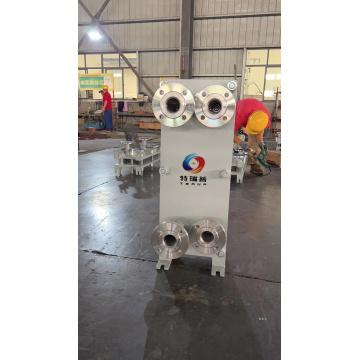
Plate Heat Exchanger plates are divided into two types: unilateral flow and diagonal flow according to the flow form of the heat exchange medium. Correspondingly, the plate heat exchanger sealing gaskets are divided into unilateral flow and diagonal flow according to the flow form of the heat exchange medium. 2 types of flow. Unilateral flow means that the heat exchange medium flowing into the right corner hole of the heat exchange plate finally flows out from the right corner hole. Similarly, the heat exchange medium flowing into the left corner hole finally flows out from the left corner hole. Diagonal flow means that the heat exchange fluid flows from the right corner hole and then flows out from the left corner hole, or the fluid flowing in from the left corner hole flows out from the right corner hole, showing a diagonal flow pattern. In terms of heat transfer efficiency, diagonal flow is better than unilateral flow, but the cost of using unilateral flow is relatively low, so when the heat exchange efficiency can be met, unilateral flow is generally used.
Plate heat exchanger sealing gaskets can be divided into three types according to the installation method on the heat exchange plate.
(1) Direct sticking type, that is, after applying sealant on the sealing gasket, stick it directly into the installation groove of the heat exchange plate.
(2) Plastic nail inlay type, that is, the heat exchange plate is designed with assembly holes, and rubber nails are designed on the side of the sealing gasket. After the sealing gasket is placed in the installation slot, the rubber nails are embedded in the assembly holes.
(3) Snap-on type, that is, there are buckles on the side of the sealing gasket, and the buckles are used to fasten the sealing gasket to the heat exchange plate. For the above three methods, the adhesive sealing gasket has a simple structure and is the easiest to process, but it is relatively troublesome to install and disassemble. Inlaid and snap-on sealing gaskets have complex structures and are more troublesome to process, but they are relatively easy to install and disassemble. Plate heat exchanger sealing gaskets are divided into symmetrical and asymmetrical types according to the product cross-section shape. The symmetrical type is generally used for diagonal flow plates. The upper and lower sealing surfaces are flat, symmetrical along the horizontal plane, and can be installed front and back. The asymmetric ground is a flat surface, and the upper sealing surface can be a flat surface, a curved surface, an inclined surface, etc.
![]() April 02, 2024
April 02, 2024